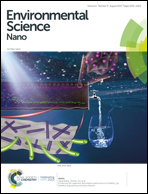Differential toxicity of anatase and rutile TiO2 nanoparticles to the antioxidant enzyme system and metabolic activities of freshwater biofilms based on microelectrodes and fluorescence in situ hybridization†
Abstract
Differential toxicities of different compositions of TiO2-nanoparticles (TiO2-NPs) to freshwater biofilms remain poorly understood. Here, we investigated this matter by subjecting bacterial and archaeal biofilms cultured in natural water from Lake Taihu in China to pollution by anatase-NPs (An-NPs) and rutile-NPs (Ru-NPs) (10 mg L−1). The related toxicity indicators and stress responses of biofilms were investigated. The metabolic capacity corresponding to O2 respiration and nitrification and the responses of ammonia-oxidizing microorganisms (AOMs) were also determined in the microenvironment. Generally, An-NPs agglomerated and were deposited on the surfaces of biofilms (up to 78%), causing massive necrosis-like death (NLD) of cells in the upper part (∼1 mm) of biofilms, which resulted from significant lactate dehydrogenase (LDH) release because of the stronger photooxidation with acellular reactive oxygen species (ROS) production. Meanwhile, due to easier access to biofilms, Ru-NPs induced apoptosis-like-death (ALD), because of substantial cellular ROS. Once TiO2-NPs and light were synergistic, the antioxidant enzyme system was able to rapidly and sensitively cope with ROS, though an incomplete defense chain occurred at 24 hours. The integrated biomarker response (IBR) indicated that An-NPs caused acute biofilm poisoning, while the toxicity of Ru-NPs gradually increased with light over time. Oxygen metabolism was only inhibited by TiO2-NPs in the upper ∼480 μm of biofilms, whereas the deeper cells in An-NP-treated biofilms became more active. However, ammonia oxidation significantly decreased, regardless of the NP type, resulting from the prominent inhibition of TiO2-NPs on ammonia-oxidizing microorganisms (AOMs) over space and time. Overall, the toxicities of TiO2-NPs were closely related to their initial characteristics and water environmental behaviors.



 Please wait while we load your content...
Please wait while we load your content...